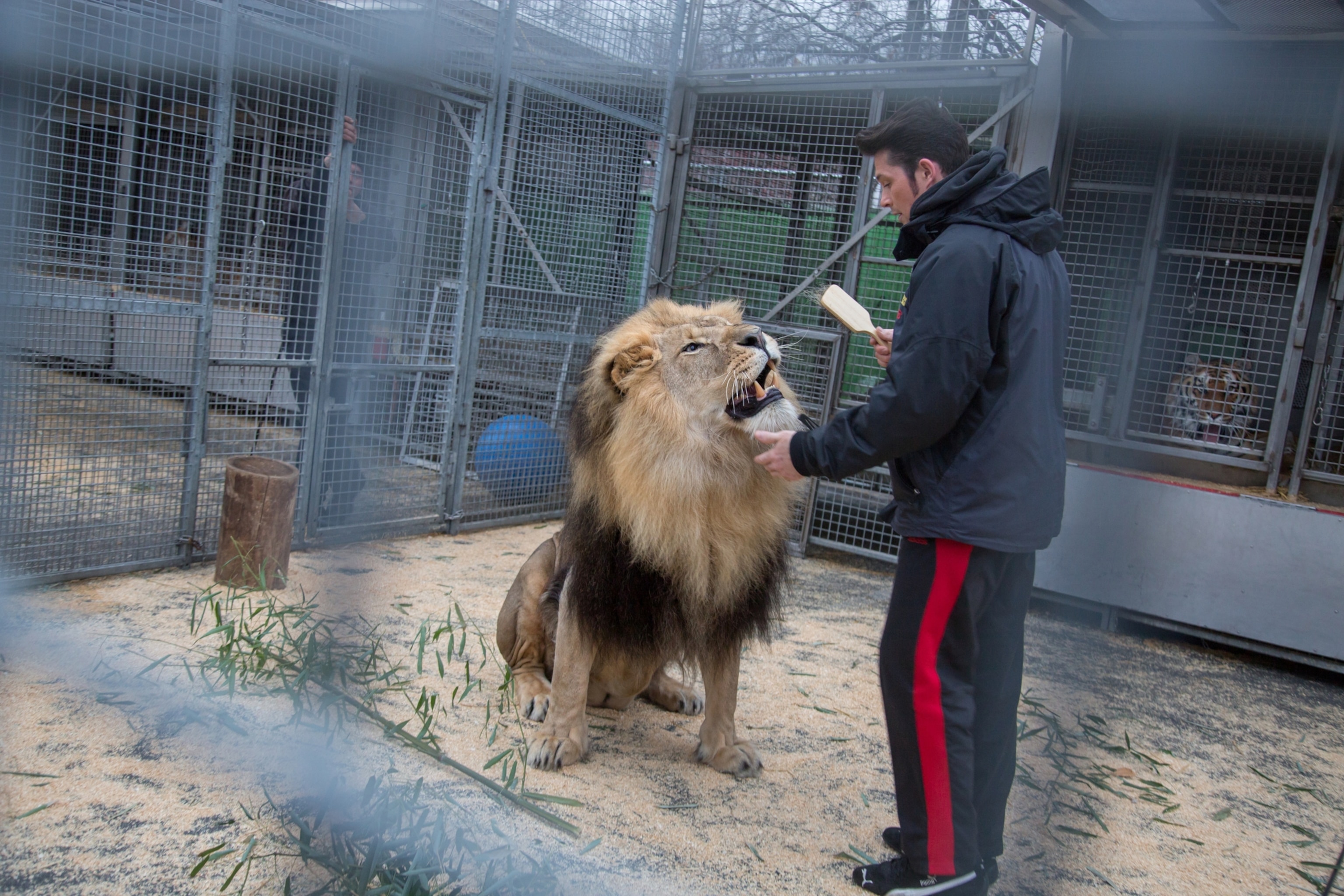
Why All of America's Circus Animals Could Soon be Free
After 146 years Ringling circus is putting on its final show. Lawmakers may unite to take all traveling exotic animals off the road.
The curtain is about to fall for the last time on the self-dubbed “Greatest Show on Earth,” America’s biggest and longest-running traveling circus. On Sunday, after 146 years, the Ringling Bros. and Barnum & Bailey Circus will pump its caravan brakes permanently. Other traveling circuses may not be far behind.
Lawmakers on both sides of the aisle have joined forces on a bill that would ban the use of exotic and wild animals in traveling circuses and any other entertainment act on wheels. In late March, Representatives Raul Grijalva, an Arizona Democrat, Ryan Costello, a Pennsylvania Republican, and 22 other lawmakers introduced the Traveling Exotic Animal and Public Safety Protection Act (TEAPSPA) in the House. It would require the 19 traveling circuses in the U.S. with performing animals to to use only human entertainers—or shut down.
If the bill passes, it will end life on the road for more than 200 big cats, bears, camels, and elephants still working as circus performers. Thirty-four other countries have instituted similar bans, as have dozens of cities and counties in the U.S., including Los Angeles and San Francisco.





DO ANIMALS NEED TO BE SAVED FROM THE CIRCUS?
The welfare issues affecting wild circus animals are long documented and numerous. Animal welfare experts have found that it's grueling and stressful for animals to always be on the road, confined to tight spaces, and made to perform before screaming audiences.
“Wild animals, even if they're born in captivity, retain all their natural instincts, which are completely thwarted when they are trapped in small cages and shuttled from city to city in trucks and trailers,” says Wayne Pacelle, president and CEO of the Humane Society of the United States.
These stresses are exacerbated by the fact that the animals must perform unnatural physical acts: bears trained to prance on tightropes; elephants made to balance on chairs; tigers forced to jump through flaming hoops. The training, lifelong and relentless, is especially hard on performing animals.

It’s the same with any wild animal forced to interact regularly with humans. For an animal to be tamed, it must be “broken” early. For elephants that means being struck with bullhooks—sharp metal poles—from a very early age, until they’re docile enough to follow commands. For elephants in circuses, the training extends further. They don’t just have to be tame enough to give tourists rides—they need to twirl and balance on their hind legs. Every time an elephant doesn’t complete a perfect turn, it may be hit or otherwise disciplined. If a big cat doesn’t behave, it may be whipped and deprived of food.
“A hundred years or so ago, when we were ignorant about the intelligence and emotions and ability of a species to communicate, we might have had the excuse of our own ignorance that we treated these animals so badly,” says Jan Creamer, founder of Animal Defenders International and an advocate for TEAPSPA. “But we simply don’t have that excuse any longer. Wild animals in circuses don’t belong in an advanced, civilized society.”


After a 2011 Mother Jones investigation exposed pervasive cruelty toward elephants at Ringling Bros, a number of petitions and public interest campaigns demanded change. Ringling took notice and in March 2015 announced that it would no longer feature elephant acts. The circus since retired its 13 elephants to Ringling’s Florida-based Center for Elephant Conservation. The circus continued to feature big cats and other animals.
RINGLING’S FINAL BOW
In the end, removing elephants wasn’t enough to save Ringling. In January, citing declining ticket sales and high operating costs, Kenneth Feld, CEO of Ringling parent company Feld Entertainment, announced the circus would close this year. It “had become an unsustainable business for the company,” he said in a statement.
Ultimately, Creamer says, Ringling may have endured if it had switched to human-only performances years ago. Cirque de Soleil is an example of a hugely successful circus that has never featured animals, she notes.
THE PEOPLE OF RINGLING







Creamer says that while Ringling’s shutdown is a win for wild animal welfare, the fight continues. It’s why TEAPSPA is necessary, she argues, even after the country’s largest circus closes its doors. According to Creamer, criminalizing the use of wild animals in circuses sends the message that the practice is wrong, and it will create a permanent solution.
“It’s unfortunate such legislation is necessary, but there are findings of systemic inhumane treatment that show a solution is needed,” Representative Costello says.
Abuse allegations continue to surface. A recent Humane Society investigation found that a tiger trainer who works with traveling shows, including the Carden Circus and Shrine Circuses, appears to have mistreated his tigers, potentially in violation of the Animal Welfare Act. The investigation, the results of which were released May 18, reveals ShowMe Tigers owner Ryan Easley on video beating his tigers with whips and sticks. One tiger was hit 31 times in two minutes.
CONGRESS LOOKS TO ACT
TEAPSPA, if signed into law, would be a blow to the businesses of Easley and others who supply exotic animals to circuses. Repeatedly introduced in Congress in recent years, the bill has failed to gain broad support. Until now Ringling was the biggest organization lobbying against TEAPSPA, the “political protector of the circus industry,” according to Pacelle. Now that Ringling is out of the mix, the bill could gain momentum.
It has another thing going for it: Animal welfare has emerged as a unifying bipartisan issue in a contentious political landscape. Representative Earl Blumenauer, a Democrat from Oregon and a co-sponsor of the bill, says working for animal protections is “a little island of tranquility and civility.”
“Animal welfare is bridge-building,” he says. “It’s where our constituents are. It’s where more and more of our colleagues are. It’s hard to describe the satisfaction when you score a victory in this area.”
Opponents of TEAPSPA include The Cavalry Group, an organization that opposes “radical animal rights groups,” according to its website. The organization says the bill “would deprive countless Americans of the ability to experience endangered animals up close such as elephants and tigers.” They argue that doing so “fosters a love of wildlife in children that lasts a lifetime.”
Creamer encourages parents instead to take their children to view wild animals in places like sanctuaries that keep animals in natural surroundings.
WHAT’S NEXT FOR THE RINGLING ANIMALS?
Feld Entertainment has applied for a U.S. Fish and Wildlife Service permit to export 15 big cats—eight tigers, six lions and one leopard—to Zircus Krone, a circus in Germany. The cats were previously imported from Germany to perform with Ringling. The Animal Legal Defense Fund objects to the export, calling instead for the big cats to be sent to a sanctuary in the U.S. USFWS invites public comment on this petition until June 26.
The company's 13 elephants have already been retired to Ringling’s Center for Elephant Conservation, not without controversy of its own. Feld Entertainment isn't otherwise publicly disclosing where the Ringling animals are going.
Creamer says that although TEAPSPA has many things working in its favor this time around, people may need to encourage their own lawmakers to sponsor the bill to improve its chances of advancing. Many lawmakers simply don’t know how important animal welfare issues are to their constituents, she says.
The bill’s backers are hopeful. “Animal welfare isn’t a partisan issue, and I am proud to work across the aisle in order to prevent these abusive practices,” Representative Costello says. “Together, we can all take part in ending animal cruelty.”
You May Also Like
Go Further
Animals
- Fireflies are nature’s light show at this West Virginia state parkFireflies are nature’s light show at this West Virginia state park
- These are the weird reasons octopuses change shape and colorThese are the weird reasons octopuses change shape and color
- Why young scientists want you to care about 'scary' speciesWhy young scientists want you to care about 'scary' species
- What rising temperatures in the Gulf of Maine mean for wildlifeWhat rising temperatures in the Gulf of Maine mean for wildlife
- He’s called ‘omacha,’ a dolphin that transforms into a man. Why?He’s called ‘omacha,’ a dolphin that transforms into a man. Why?
Environment
- What rising temperatures in the Gulf of Maine mean for wildlifeWhat rising temperatures in the Gulf of Maine mean for wildlife
- He’s called ‘omacha,’ a dolphin that transforms into a man. Why?He’s called ‘omacha,’ a dolphin that transforms into a man. Why?
- The northernmost flower living at the top of the worldThe northernmost flower living at the top of the world
- This beautiful floating flower is wreaking havoc on NigeriaThis beautiful floating flower is wreaking havoc on Nigeria
- What the Aral Sea might teach us about life after disasterWhat the Aral Sea might teach us about life after disaster
History & Culture
- Scientists find evidence of ancient waterway beside Egypt’s pyramidsScientists find evidence of ancient waterway beside Egypt’s pyramids
- This thriving society vanished into thin air. What happened?This thriving society vanished into thin air. What happened?
Science
- Why pickleball is so good for your body and your mindWhy pickleball is so good for your body and your mind
- Extreme heat can be deadly – here’s how to know if you’re at riskExtreme heat can be deadly – here’s how to know if you’re at risk
- Why dopamine drives you to do hard things—even without a rewardWhy dopamine drives you to do hard things—even without a reward
- What will astronauts use to drive across the Moon?What will astronauts use to drive across the Moon?
- Oral contraceptives may help lower the risk of sports injuriesOral contraceptives may help lower the risk of sports injuries
- How stressed are you? Answer these 10 questions to find out.
- Science
How stressed are you? Answer these 10 questions to find out.
Travel
- Fireflies are nature’s light show at this West Virginia state parkFireflies are nature’s light show at this West Virginia state park
- How to explore the highlights of Italy's dazzling Lake ComoHow to explore the highlights of Italy's dazzling Lake Como
- Going on a cruise? Here’s how to stay healthy onboardGoing on a cruise? Here’s how to stay healthy onboard
- What to see and do in Werfen, Austria's iconic destinationWhat to see and do in Werfen, Austria's iconic destination







